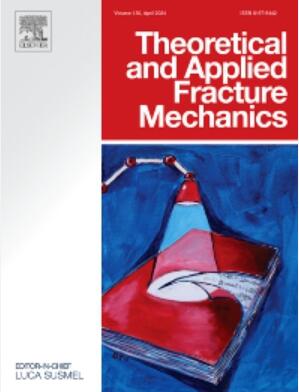Experimental study of type-I crack propagation in rock monitored by fiber Bragg grating
IF 5
2区 工程技术
Q1 ENGINEERING, MECHANICAL
引用次数: 0
Abstract
The occurrence of rock mass engineering disasters can be reduced significantly by obtaining the key information in the process of rock internal fracture accumulation and evolution through advanced monitoring means and taking certain preventive measures. Through fiber Bragg grating monitoring tests of the type-I crack propagation in rock, the spectral characteristics of the fiber Bragg grating in the process of rock failure were analyzed, the bandwidth expansion was extracted to characterize the local tensile strain during the crack propagation process, and the damage variable based on the bandwidth expansion was calculated to describe the type-I crack propagation process. The research results showed the following: (1) The fiber Bragg grating generated a non-uniform local tensile strain during type-I crack propagation. The bandwidth expansion of the wave spectrum was positively correlated with the local tensile strain. The change in the characteristics of the wave spectrum could provide the local real strain in the process of crack propagation. (2) During the steady propagation of the type-I crack, the bandwidth increased obviously, while the number of acoustic emission events was relatively small, and most of them were in the process zone. The gentle increase in the bandwidth corresponded to the unstable growth stage of the type-I crack, which could be used as a precursor of rock sample instability. During loading, the maximum tensile strain of the type-I crack was 6 %, while the maximum shear strain reached 1.8 %, primarily attributed to tensile failure. The average value of fracture toughness KIC, based on the equivalent linear elastic fracture mechanics model, was determined to be 1.21 MPa·m1/2, and the average value of fracture energy Gf was calculated as 57.7 N/m. The variation of peak reflectivity in fiber Bragg grating was associated with the closure of pre-existing defects and the propagation of microcracks in rocks, resulting in unstable shear strain at crack extension sites. (3) The damage variable D defined by the bandwidth broadening began to become concentrated and accumulated in the crack steady growth stage, and it increased slowly in the crack intensification and evolution stage. The grating was sensitive to changes when it was pasted to the surface at 90°, but it could easily fracture or become unable to capture spectral signals in time. Based on a comprehensive comparison, the monitoring effect was the best when the grating was pasted at 60° relative to the crack.
利用光纤布拉格光栅监测岩石中 I 型裂缝扩展的实验研究
通过先进的监测手段获取岩石内部裂隙积累和演化过程中的关键信息,并采取一定的预防措施,可以大大减少岩体工程灾害的发生。通过光纤布拉格光栅对岩石中 I 型裂缝扩展的监测试验,分析了光纤布拉格光栅在岩石破坏过程中的光谱特征,提取了带宽扩展来表征裂缝扩展过程中的局部拉应变,并计算了基于带宽扩展的破坏变量来描述 I 型裂缝的扩展过程。研究结果表明(1) 在 I 型裂纹扩展过程中,光纤布拉格光栅产生了不均匀的局部拉伸应变。波谱的带宽扩展与局部拉伸应变呈正相关。波谱特征的变化可提供裂纹传播过程中的局部真实应变。(2) 在 I 型裂纹的稳定扩展过程中,带宽明显增大,而声波发射事件的数量相对较少,且大部分位于过程区。带宽的平缓增加与 I 型裂纹的不稳定生长阶段相对应,可作为岩样不稳定的前兆。在加载过程中,I 型裂缝的最大拉伸应变为 6%,最大剪切应变为 1.8%,主要归因于拉伸破坏。根据等效线性弹性断裂力学模型,断裂韧性 KIC 的平均值为 1.21 MPa-m1/2,断裂能 Gf 的平均值为 57.7 N/m。光纤布拉格光栅峰值反射率的变化与岩石中原有缺陷的闭合和微裂缝的扩展有关,导致裂缝扩展部位产生不稳定的剪切应变。(3) 由带宽展宽定义的损伤变量 D 在裂纹稳定增长阶段开始集中和累积,在裂纹强化和演化阶段缓慢增加。光栅与表面成 90°粘贴时对变化敏感,但容易断裂或无法及时捕捉光谱信号。经过综合比较,光栅与裂纹成 60 度粘贴时的监测效果最好。
本文章由计算机程序翻译,如有差异,请以英文原文为准。
求助全文
约1分钟内获得全文
求助全文
来源期刊

Theoretical and Applied Fracture Mechanics
工程技术-工程:机械
CiteScore
8.40
自引率
18.90%
发文量
435
审稿时长
37 days
期刊介绍:
Theoretical and Applied Fracture Mechanics'' aims & scopes have been re-designed to cover both the theoretical, applied, and numerical aspects associated with those cracking related phenomena taking place, at a micro-, meso-, and macroscopic level, in materials/components/structures of any kind.
The journal aims to cover the cracking/mechanical behaviour of materials/components/structures in those situations involving both time-independent and time-dependent system of external forces/moments (such as, for instance, quasi-static, impulsive, impact, blasting, creep, contact, and fatigue loading). Since, under the above circumstances, the mechanical behaviour of cracked materials/components/structures is also affected by the environmental conditions, the journal would consider also those theoretical/experimental research works investigating the effect of external variables such as, for instance, the effect of corrosive environments as well as of high/low-temperature.
 求助内容:
求助内容: 应助结果提醒方式:
应助结果提醒方式:


